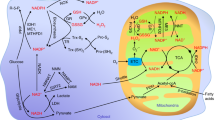Abstract
Redox signalling is increasingly recognized to play a crucial role in cellular and organismal physiology. Whilst we have made considerable advances in recent years with respect to understanding the roles and regulation of many different cellular redox species, research remains restricted by a lack of appropriate tools and techniques. Here we discuss the opportunities afforded by recently developed genetically encoded redox sensors and illustrate how they have already advanced our understanding.
Similar content being viewed by others
Literatur
Holmström KM, Finkel T (2014) Cellular mechanisms and physiological consequences of redox-dependent signaling. Nat Rev Mol Cell Biol 15:411–421
Ostergaard H, Tachibana C, Winther JR (2004) Monitoring disulfide bond formation in the eukaryotic cytosol. J Cell Biol 166:337–345
Dooley CT, Dore TM, Hanson GT et al. (2004) Imaging dynamic redox changes in mammalian cells with green fluorescent protein indicators. J Biol Chem 279:22284–22293
Hanson GT, Aggeler R, Oglesbee D et al. (2004) Investigating mitochondrial redox potential with redoxsensitive green fluorescent protein indicators. J Biol Chem 279:13044–13053
Schwarzländer M, Wagner S, Ermakova YG et al. (2014) The ‘mitoflash’ probe cpYFP does not respond to superoxide. Nature 514:e12–E14
Meyer AJ, Brach T, Marty L et al. (2007) Redox-sensitive GFP in Arabidopsis thaliana is a quantitative biosensor for the redox potential of the cellular glutathione redox buffer. Plant J 52:973–986
Gutscher M, Pauleau AL, Marty L et al. (2008) Realtime imaging of the intracellular glutathione redox potential. Nat Methods 5:553–559
Gutscher M, Sobotta MC, Wabnitz GH et al. (2009) Proximity-based protein thiol oxidation by H2O2-scavenging peroxidases. J Biol Chem 284:31532–31540
Schwarzländer M, Fricker MD, Müller C et al. (2008) Confocal imaging of glutathione redox poise in living plant cells. J Microsc 231:299–316
Schwarzländer M, Dick TP, Meyer AJ et al. (2015) Dissecting redox biology using fluorescent protein sensors. Antioxid Redox Signal, doi: 10.1089/ars.2015.6266
Morgan B, Ezerina D, Amoako TN et al. (2013) Multiple glutathione disulfide removal pathways mediate cytosolic redox homeostasis. Nat Chem Biol 9:119–125
Minich T, Riemer J, Schulz JB et al. (2006) The multidrug resistance protein 1 (Mrp1), but not Mrp5, mediates export of glutathione and glutathione disulfide from brain astrocytes. J Neurochem 97:373–384
Martinoia E, Grill E, Tommasini R et al. (1993) ATPdependent glutathione S-conjugate ‘export’ pump in the vacuolar membrane of plants. Nature 364:247–249
Lu Y-P, Li Z-S, Drozdowicz YM et al. (1998) AtMRP2, an Arabidopsis ATP binding cassette transporter able to transport glutathione S-conjugates and chlorophyll catabolites: functional comparisons with AtMRP1. Plant Cell 10:267–282
Kojer K, Bien M, Gangel H et al. (2012) Glutathione redox potential in the mitochondrial intermembrane space is linked to the cytosol and impacts the Mia40 redox state. EMBO J 31:3169–3182
Hwang C, Sinskey AJ, Lodish HF (1992) Oxidized redox state of glutathione in the endoplasmic reticulum. Science 257:1496–1502
Author information
Authors and Affiliations
Corresponding authors
Additional information
Bruce Morgan Jahrgang 1980. Mikrobiologiestudium an der University of Wales in Cardiff, UK. 2007 Promotion an der University of Manchester, UK. 2008–2009 wissenschaftlicher Mit arbeiter. 2010–2014 wissenschaftlicher Mitarbeiter am Deutschen Krebsforschungszentrum (DKFZ), Heidelberg. 2015 Gruppenleiter in Zellulärer Biochemie, TU Kaisers lautern.
Markus Schwarzländer Jahrgang 1982. Chemie- und Biochemiestudium an der LMU München. 2009 Promotion an der University of Oxford, UK. 2009–2011 Weston Junior Research Fellow am Department of Plant Sciences und New College, University of Oxford. 2011–2013 wissenschaftlicher Mitarbeiter an der Universität Bonn; dort seit 2013 Emmy Noether-Nachwuchsgruppenleiter in Plant Energy Biology.
Rights and permissions
About this article
Cite this article
Morgan, B., Schwarzländer, M. Fluoreszierende Proteinsensoren für die Redoxregulation in lebenden Zellen. Biospektrum 22, 260–263 (2016). https://doi.org/10.1007/s12268-016-0683-2
Published:
Issue Date:
DOI: https://doi.org/10.1007/s12268-016-0683-2




